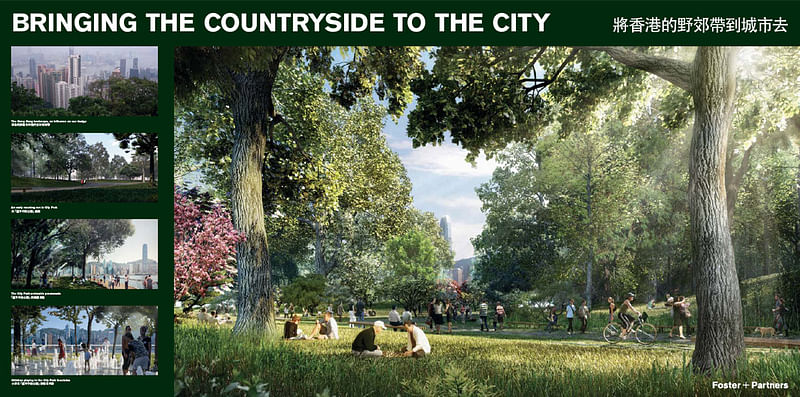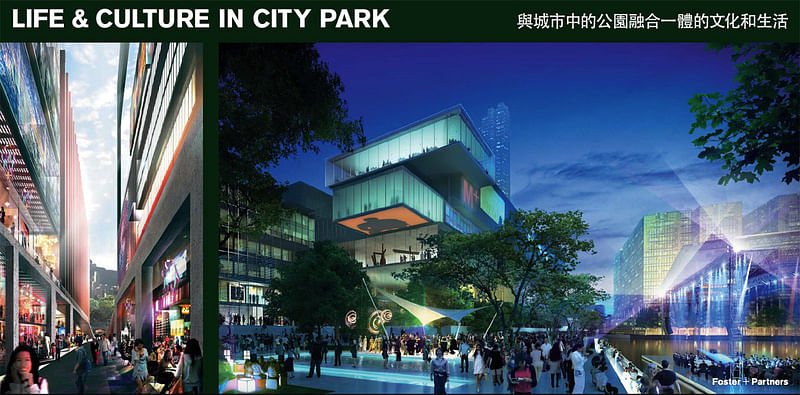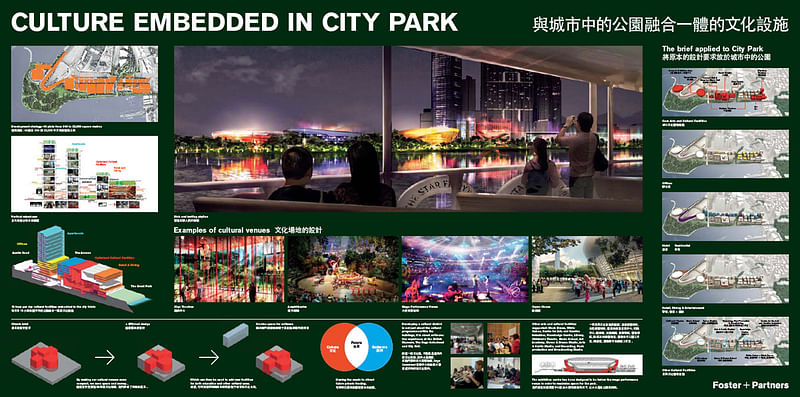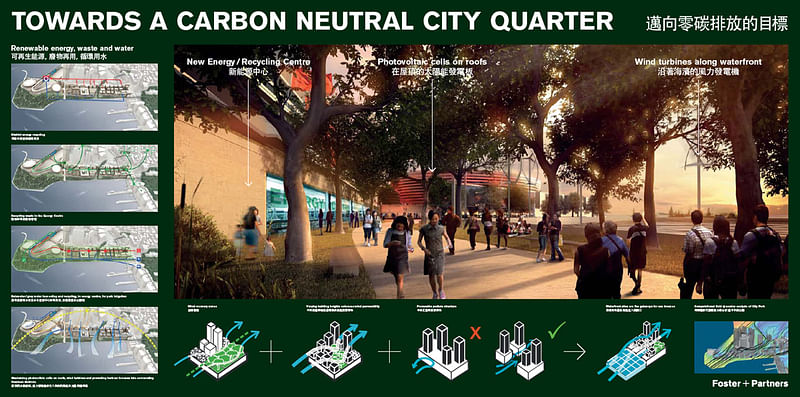West Kowloon Cultural District Concept: "City Park" by Foster + Partners
By Bustler Editors|
Tuesday, Aug 24, 2010

Related
Three Conceptual Plan Options for the West Kowloon Cultural District (WKCD) have been unveiled during the opening ceremony for the Stage 2 Public Engagement exercise.
Following is the concept "City Park" – prepared by team Foster + Partners, led by Lord Norman Foster. The vision shown in the plans is conceptual only and will be subject to statutory constraints and further review. The designs of individual buildings are for illustrative purposes only and actual building designs will be developed in a later stage according to Town Planning Ordinance.
Detailed information about the Foster + Partners concept can be found here.
From Foster + Partners' Consulation Digest: "We have created the framework for an urban quarter in West Kowloon with all these ingredients – a magnificent park, a continuous waterfront, iconic cultural venues, colonnaded avenues, tree-lined streets and intimate lanes; green spaces offering tranquility, and urban spaces that are inspired by the energy and rich mix of Kowloon's streetscapes.
All these places and spaces are supported by a network of service roads below ground and a public transport system above. The whole quarter is carbon neutral."

Lord Foster, Founder and Chairman, Foster + Partners said: “Hong Kong is a great city and this project captures what is important about its DNA: the civic spaces, the squares, the parks, the greenery, the avenues and the small side streets. At ‘City Park’ we have created a world class setting for a new cultural city for everyone.”

Mouzhan Majidi, Chief Executive, Foster + Partners said: “The West Kowloon Cultural District is an ambitious project to create a dynamic new district with a rich mix of spaces for everyone in Hong Kong. Our approach is to create a masterplan where the boundaries between living, working and playing are blurred, public space is welcoming and lively, and the quality of urban life is substantially improved. We look forward to carrying out further work on this exciting endeavour.”

Spencer de Grey, Head of Design, Foster + Partners said: “City Park belongs to the people of Hong Kong. What we have done is taken our years of experience here, listened to what people need and created a setting for a new world class cultural district that expresses the hopes and aspirations of the city. It will be the most extraordinary international destination – a new landmark on the world’s cultural map.”




Work on the WKCD will be phased and the venues include:
The Great Park and green avenue
Characterised by an organic landscape, the Great Park is a twenty-three-hectare green oasis, including a nineteen-hectare park, on the western promontory of the site. It not only provides the setting for three major venues – the Arena, the Exhibition Centre and the Opera House – but also contains tea houses, small temples, follies, picnic areas and informal sports pitches within its hills and densely planted trees.
The Arena and Expo
A reinvention of a building type, the Arena and Expo centre contains a stacked programme – combining two functions within one compact form. With the arena constituting a large-scale performance venue on the upper levels, the expo centre is dug-into the site, below ground. The benefit of this unique programme is that it not only frees space for more parkland, but also concentrates two heavily serviced buildings within one, thereby reducing the infrastructure required for access and services for each. While the Expo centre will be full of activity during the daytime, the Arena will host events at night, thus creating a lively 24-hour shopping and entertainment centre.
Habitable Wall
Sweeping around the inner perimeter of the park and establishing a buffer to the West Harbour Crossing, a “green wall” contains hotels, restaurants, conference facilities and the showcase energy centre that serves the whole site.
Great Opera House
The home of WKCD’s resident opera company, the Great Opera House nestles within the Great Park, flanking its north-eastern edge and representing the western culmination of the Avenue. The Great Opera House marks the transition from city to park-scape. In front of the Great Opera House is Opera Plaza, which can be used for informal events and temporary exhibitions. This space sits within the park and offers spectacular views of the Bay and the Hong Kong skyline.
Green Rooms / the Urban Edge
With services and infrastructure placed below ground and the level of the development dictated by the buried Express Rail Link station, the public urban realm of WKCD is raised three metres above the current topographic datum. The city therefore steps down to the water’s edge, establishing dramatic views across the bay. A series of ‘green rooms’ step down from the cultural venues along the site edge, and extend towards Kowloon Park. Each room has a distinct identity, with the level change offering potential for terraced gardens, stepped plazas and integrated services and kiosks.
The Avenue
The Avenue, a bustling, wide boulevard-like pedestrian street, is the central spine running east/west from the Great Opera House at the edge of the Great Park, to Black Box Tower and Canton Road Plaza Gateway. The Avenue unlocks the whole district, connecting all the different elements together, and is characterised by a dynamic mix of major cultural venues, along with shops, noodle bars, private galleries, artists’ studios, workshops and residential apartments. A network of smaller streets intersect the Avenue, offering specialist culture-related shopping and cultural experiences. At the far western end of the Avenue, a bridge leads directly to Elements shopping centre and to Kowloon MTR station, while at the far eastern end, Austin Bridge connects directly to Austin Station and to King George IV Memorial Park beyond.
Xiqu Plaza and the Chinese Theatre
At the centre of the Avenue, adjacent to the Chinese Theatre, Xiqu Plaza is the centrepiece of the district. Occupying a strategic location, Xiqu Plaza connects to the forecourt plaza of the Express West Kowloon Terminus Rail Link, establishing a dramatic gateway to the development on arrival by train with a view corridor towards the Hong Kong skyline. The social heart of West Kowloon Cultural District, the plaza is filled with food stalls, organic markets, restaurants and cafes. The square is influenced by the presence of the adjacent Chinese Theatre, with its generous overhanging roof, beneath which there are restaurants and cafes. This establishes a traditional Chinese identity for the entire district.
Art School, Theatre and Academy, Music Square
Adjacent to the Great Opera House, a mixed-programme development would house an art school on the upper levels, with a music academy on the lower levels and theatre below grade. To the north of the building, a public square establishes an outdoor social space, with temporary music-related events or installations and a possible showcase for the art school and music academy. Rising above the height of the surrounding buildings, the art school is a bold marker, with spectacular views towards Hong Kong and an external rooftop terrace with sculpture garden.
The Concert Hall and Symphonic Stairs
The concert hall is defined by its raised public terrace that steps up, dramatically, from the waterfront. A key viewing point for the Hong Kong skyline, audiences are able to watch performances against the backdrop of Hong Kong. Equally, the building’s strong form is a civic and cultural marker for the cultural district, when viewed from Hong Kong. A music centre of international standing, the concert hall will consolidate West Kowloon’s position as an arts destination in its own right.
East of Xiqu
A number of further venues and public squares extend eastward from Xiqu Theatre. Characterised by a mixed programme of commercial, education and cultural uses, these include recording studios, the White Box gallery, Literature Square and Dance studios.
Knowledge Centre
The Knowledge Centre is located to the south of West Kowloon Terminus and Austin Station, connecting to East Gate Plaza and Austin Bridge to the east. A 21st century library and centre for learning and literature, the Knowledge Centre is welcoming and accessible, offering visitors and the local community a place to learn, meet, research and spend leisure time. Containing a library, computer rooms with wi-fi, the building is also home to exhibitions relating to literature and local history and culture. The programme suggests open, flexible environments in which communication can flourish.
M+
WKCD’s pioneering museum of modern art, M+ is accessed from the Avenue, near to Kowloon Park Bridge on the waterfront. Flanked by two plazas, the venue is also home to a sculpture-making courtyard to the east and a sculpture garden to the west. The building is characterised by its flexible exhibition spaces – including spaces for large-scale installations – as well as additional functions, such as lecture theatres, an archive of Chinese painting, art storage and a roof-top restaurant and sky-garden. A pedestrian public route leads through the site, reinforcing its integration into the wider city context. A major international centre for the visual arts, M+ is ranked among the world’s elite modern arts institutions, such as the Pompidou Centre in Paris and Tate Modern in London.
Canton Road Plaza and Black Box Tower
The Avenue culminates, at its far eastern end, in the Canton Road Plaza and the distinctive Black Box Tower. The tower houses a twenty-four-hour bookshop at the lower level, with three theatres stacked above, hosting fringe performances and comedy.
Connections and transport integration
Central to the vision for WKCD is the seamless integration of public transport and connections to Hong Kong, China and beyond. There are footbridges to Austin Station, Elements shopping centre, Kowloon Park and West Kowloon Station (with trains to the airport taking just twenty minutes). There is also the China ferry terminal to the East and the Star Ferry terminal close to the concert hall with regular connections to Hong Kong. The infrastructure for the entire site is discreetly placed below grade, with deliveries and service access to the venues separated from the predominantly pedestrian ground level. An automated transit system is proposed, which would connect all venues, keeping walking distances to a minimum and strategically connecting all the dots on the transport map. A fleet of eco minibuses connects further into central Kowloon areas.

Share
0 Comments
Comment as :